Over the last few weeks, we transitioned Mazzy from a bottle to a cup. Our doctor told us at a year that she should be fully transitioned by 15 months (which is today if you must know) so thankfully, we snuck in right under the wire.
Nobody really talks about the bottle-to-cup thing being a big deal but I actually found it more excrutiating than our sleep training experience which says A LOT. This difficulty was mainly because Mazzy now has the ability to tell us exactly what she wants. And it’s a lot harder to look your child in the eye and tell her “no” when she is communicating successfully.
To make it worse, we did a lot of questionable things that didn’t help the process. Like using the cup only for water in the beginning and then not knowing how to convince her that there was now milk inside. Mazzy fought that cup tooth and nail, so ultimately, we felt we had no choice but to go cold turkey.
Hence, the “Two Weeks of Hysterics”. Mazzy played up her sadness and anger with such over-the-top drama, you would have thought she was auditioning for a role on a Spanish soap opera.
To be fair, she was dealing with her first real loss.
It’s now been just over three weeks and FINALLY, Mazzy has stopped requesting or mentioning “baba”. Although, I have noticed that in the process, she has become a lot more dependent on her BOO and her pacifier.
What I should have done was consult with Dr. B before I started. So in case some of you have yet to go through the bottle-to-cup transition, I asked her to put together some tips to make it easier for you than it was for us.
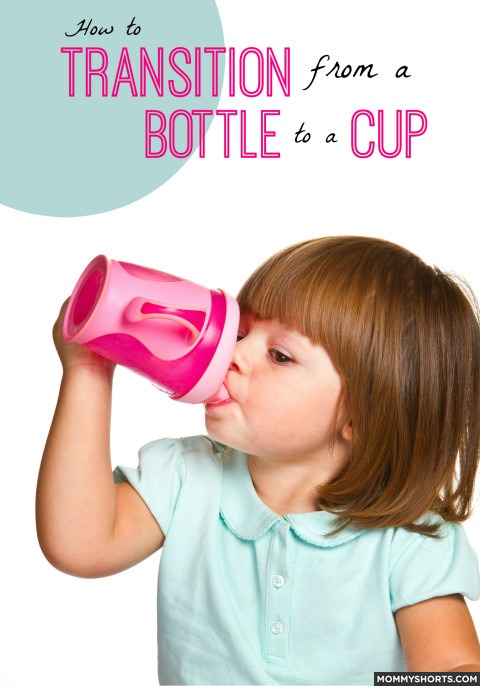
Dr. B Presents: How to Transition From a Bottle to a Cup
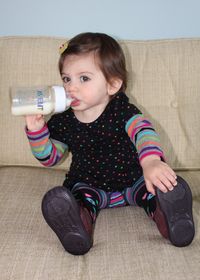 Pediatricians recommend introducing the sippy cup at around 6 to 9 months of age and children are typically able to master the motor skills required to drink from a cup between 12 to 15 months. It is important to make the transition from bottle to cup because there are many studies that suggest that prolonged bottle feeding can lead to negative outcomes including tooth decay, excessive milk intake, and a lack of adequate nutrients (especially iron) for healthy growth. Although there is no one right way to transition a child from the bottle to cup, below are some suggestions for making the transition easier:
Pediatricians recommend introducing the sippy cup at around 6 to 9 months of age and children are typically able to master the motor skills required to drink from a cup between 12 to 15 months. It is important to make the transition from bottle to cup because there are many studies that suggest that prolonged bottle feeding can lead to negative outcomes including tooth decay, excessive milk intake, and a lack of adequate nutrients (especially iron) for healthy growth. Although there is no one right way to transition a child from the bottle to cup, below are some suggestions for making the transition easier:
1) Start early: Introduce the sippy cup at 6 months to get your child acquainted with it before it is necessary for them to give up the bottle. Children who are older than 1 year often have a much more difficult time with this transition because the bottle becomes associated with comfort and security and is often used for soothing the child before naps and bedtime.
2) Introduce the sippy cup in a fun way: Show your child how to drink from the cup and encourage them to imitate you. Start by filling it with a little water and celebrate each successive approximation toward the end goal of drinking from the cup (e.g., first clap for your child when they put the cup close to their mouth, then wait to cheer when they tip it slightly with your assistance, then give the BIG reaction when they get some water in their mouth and say “Yummy!”). When they start to get the hang of it, begin filling the cup with milk, giving them an instant natural reward for their efforts.
3) Try different sippy cups: Sippy cups come in all different sizes and colors. The spouts vary in texture and size and some children respond better to one type of cup over another. Some sippy cups have special characters or animals on them that may grab your child’s attention. Use trial and error to determine the best sippy cup for your child.
4) Dilute the bottle milk: Gradually add water to the bottle milk so that after a week or two the bottle contains only water. At the same time, offer the sippy cup with the milk your child desires. You can also try to reduce the amount of liquid in the bottle and present the sippy cup alongside the bottle with plenty of milk. This will encourage your child to try it when they seem dissatisfied with the contents of their bottle. The goal is to make the sippy cup more rewarding than the bottle.
5) Eliminate bottle feedings gradually: Reduce bottle feedings systematically. Each week, remove one bottle feeding and offer a sippy cup instead. Start by eliminating the midday bottle first, then the morning bottle, and finally the evening bottle. By the time the evening bottle is left, the bottle should be filled with only water. Milk should only be given in a sippy cup.
6) Out of sight, out of mind: Remove all bottles from your child’s view during the weaning process. Only take the bottle out when necessary. If your child requests a bottle anyway and you have already determined that a bottle should not be given at that time, offer the sippy cup and food instead. This may cause some crying the first few days but be persistent and don’t give in because it will only delay the process and make the transition more difficult for you and your child.
The best timeline and approach to use for the transition from the bottle to the cup will differ depending on the child. Some children adjust easily and don’t need the process to be dragged out, while other children are very attached to their bottles and may need a little extra time. Although this transition can be difficult, it is vital because when children reach 1 year, milk no longer contains all the nutrients necessary for healthy growth.
Editor’s Note: Mazzy’s even using the handleless cup now but I don’t have a picture.
Dr. B has a PHD in school psychology and specializes in early childhood development. If you have a question for Dr. B, please email me by clicking here.













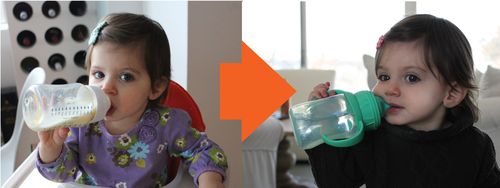
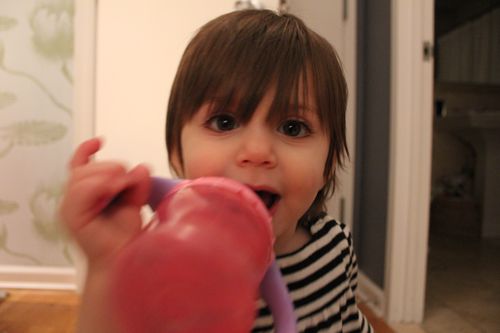
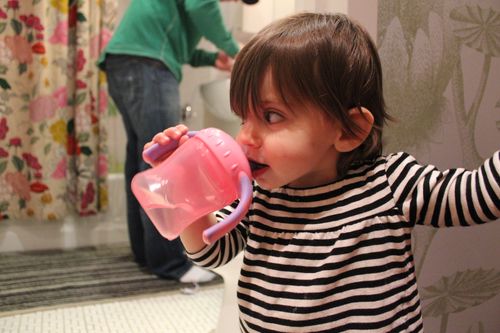
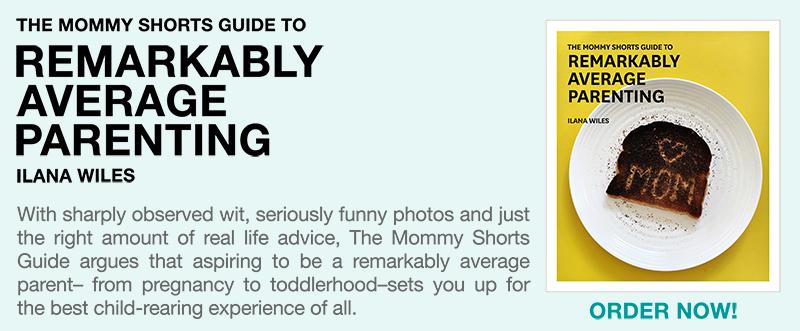




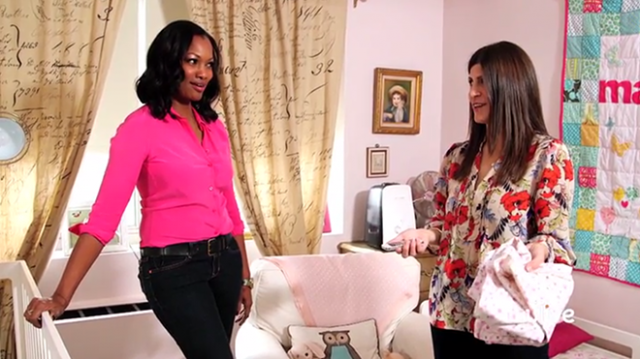






I had THE hardest time with Kate. We had to go cold turkey to a cup because she wouldn’t transition. And with Maddie? I had to open her sippy the first few times, give her a taste of the milk inside, and then screw the top back on so she trusted it wasn’t water!
I agree with cheering tactics of #2 but offer this caveat: While you’re jumping like a college cheerleader on Red Bull because your child so much as looked at a sippy cup, make sure your single friends are NOT around to witness it. I don’t think my sister has visited since.
I must say, this is one problem I never had to deal with.
As an extremely stubborn stay at home mom – even with nursing issues at the beginning, I nursed them both until about 17 months old (started weaning at 12 months when they were able to have whole milk). The only times they had a bottle were in the first several months when I pumped milk in an effort to sleep longer than 2-3 hours at a time.
My two problems instead: telling my baby-sitter to give a bottle around six months after two months of not having one while I went on a date with my husband (yeah, that was bad) and convincing my children that milk can come in a cup, not just me.
Look at that hair on Mazzy. They grow so fast.
Have you tried a cup with a straw instead of a “sippy”?? Surprisingly Jake took to the straw immediately. The Nuby flip it cup is what he uses and so far its working well, although we havent made the move to real milk yet. He will be one in a few weeks so Im a little nervous about the transition to milk and no more bottles!
I have actually blocked this process out of my memory.
I don’t recall WHAT we did.
Huh.
That suggests either great smoothness or great trauma.
Knowing my son, either is equally likely.
We had a really hard time transitioning my son to a cup…not because he freaked out without his bottles. It was that he refused to drink out of the cup unless someone held it for him. He would not tip his head back to drink out of it. Right after he turned one, we went cold turkey on the bottles and just gave him cups. He was fine with it, but refused to hold the cup himself. It was only when he was about 14 months old and we went on vacation that we discovered he liked to drink out of straws. So, we got him straw sippy cups and it worked. He is just now (at 22 months) comfortable with regular cups, though he still prefers the ones with straws.
What a great post! We kind of winged it and got lucky, but a lot of the strategies you mention here were strategies we used. We used the toss and go cup with smaller bottoms when he was really little to get him started with it (it was just there during dinner time). Then we tried the straw which worked great, but he would only drink water from it, not milk. So then we went to the sippy cup Mazzy is drinking up at the top which is a nice transition since it is flexible like the bottle nipple. Finally we transitioned to the sippy cup that Mazzy is drinking from at the end. We are just starting to give him sips from a real cup now and he loves it! I will say that sometimes he would get finicky about the sippy cup so I added a tiny bit of apple juice to flavor the water. The usually was enough to get him over the hump with the sippy cup for that day. 🙂
We actually gave Mazzy a cup pretty early on but realized too late that she had basically been using it as a chew toy for months. I don’t think she ever really got any liquid out of it until we took away the bottle.
I find this to be the case in all positive reinforcement situations. Also? In aforementioned scenarios, the pitch of my voice is about fifty times higher than normal.
I was working full-time for awhile so we had to transition Mazzy to a bottle during the day. We were told to do it before six weeks so she wouldn’t refuse it. Eventually she preferred the bottle to the breast. But regardless, she had exclusively breastmilk until I weaned her just before her first birthday. I just pumped like a mad woman the whole time.
We tried EVERYTHING. Nuby flip cup included. She actually likes using a regular grownup straw but does not like the hard plastic ones that come with the sippy cups. She just removes the straw and starts to play with it.
Consider yourself lucky. I think this traumatic experience will be with me for quite some time.
Mazzy always loved to drink out of MY glass while I was holding it so I never anticipated that giving her her own would be such a problem. But one thing that it was hard to teach her was to put her head back. She just kept wanting to lunge forward into the cup. Which doesn’t get her anywhere. So she would just end up chewing on the spout.
After trying countless cups, we have finally found that the disposable plain colored cups with the lids, no handle, are Mazzy’s favorite. They come in a pack with five colors.
But Mazzy will only use the orange one.
Kids are weird.
My 22 month old is still on bottles. I’ve tried everything I can to get him to use a sippy cup. He doesn’t like juice, so all he gets in his bottle is milk or water. But I’ve tried at least 10 different cups and he won’t even try them. I’ve tried showing him how to use them. He throws them in anger. I refused to let him have his bottle but after 8 hours I caved and gave it back because I was afraid he’d get dehydrated. He’s so stubborn. Getting rid of his pacifer was easy as pie…but he’s really making up for it in the bottle department. My doctor keeps telling me “it’ll work itself out” but I don’t think so. I think I need to DO something. I just don’t know what to do. Maybe Dr. B could help?
My little guy is almost 2 and I’ve got rid of all the bottles except the one he has in the morning… He loves it so much, I’m not sure how this is gonna go when we take it away… Although we better start soon because his 24 months appoitment is coming up and his pediatrician is going to kick my butt if he’s still on the bottle… I should tell him to call my mum who considers herself a pediatrician after raising 3 kids and who LOVES to challenge everything my pediatrician says based on the fact that she didn’t do most of it when we were kids, and the all-time favorite ‘here in France that’s how we do it and the kids are fine, look at so and so kids…’ I can never win…
Rebecca actually took to the sippy cup pretty well, but she wont’ drink anything but milk out of it. (No juice, no water). So the comment about excessive milk intake has me wondering if I have a different issue to address…
I am so glad you did a blog on this! Tom is still using the bottle (he’s 13 months now) and I am the one who is totally putting it off. He uses the sippy cup for water right now, but I love the advice about switching it up. I hadn’t heard that before. So…maybe it’s time. Maybe. 🙂
Those two handled Nuby cups I found dripped more – the handle-less ones were better. 😉
Was wondering if anything I did helped at all. I hope so. And, yes, kids are weird. But don’t stop giving her the cups in other colors. God forbid the orange one breaks – you will be screwed.
It was INCREDIBLY hard for us too. She said no. She threw the cup. She refused to drink. Screamed for baba constantly. But because we were brutal about it, she came around. Eventually.
Honestly, the trick is not to cave. And to be CONSISTENT. Try a period where he only gets the bottle before bed but he can’t have it during the day. But make sure there is always a cup full of milk available to him at all times. And I think step 4 could really work for you. I wish we had done that. And 6 is really crucial.
I think you helped a ton. You enforced it the whole day that we went skiing so then when we got back, I felt like if we caved, we would mess up all the work you put in throughout the day. In my mind, if I went backwards, I would just send a confusing message. So thank you for giving me some balls:)
yes, that is definitely an added benefit of the handle-less. The dripping sucks.
I would switch up the milk and water pronto. That was one of the biggest hurdles that we had to get over. Trying to get her to disassociate milk with the bottle and water with the cup.
You may find it to be much easier than we did. But if not, better to get it over with.
I think the danger is if they fill up on milk, they will be less likely to eat more of other things. Our doctor told us to keep milk intake between 16-24oz. And when she became really constipated, she told us to keep it closer to 16oz. Which was a lot less than we were used to. We end up diluting a lot.
I would think if he is fine with the cup during the day, it won’t be that big of a deal to take the bottle away in the morning. A few months ago, I stopped giving Mazzy a bottle before bedtime because I wanted her teeth to be freshly brushed and because she was already getting her quotient of milk throughout the day. I thought it was going to be really painful but it was no big deal.
Oh, the sleep training experience! Let’s not even go there. Glad you made the cup transition successfully – and love the name Mazzy!
Thanks for stopping by my place!
I will also confess that I keep putting it off by coming up with excuses. My excuse this week is that he’s teething and if he gets more terrible right now I’m going to have to run away. Far, far away. (And I’m never coming back!) But seriously, great advice. I will switch it up. Right before I run away.
I remember those days! Currently I’m dealing with potty training and getting rid of the pacifier. My youngest will be 3 next month. Both have to be accomplished by then. Ahhhh!!!
*Deep breath* I’m gonna do it. The bottles are going in the GARBAGE the day after his 2nd birthday. I have bookmarked this post for then.
Potty training seems harrowing. If you’d like any tips to ease the process (and by process I mean cleaning poop off the floor), don’t hesitate to ask Dr. B!
Thank you for the compliment on the name! We get mixed reactions but mostly positive.
It also helsp to not allow your baby to ever hold the bottle (without Mommy’s hands) during feeding because then they have the control over it. Also to never allow your baby to go to bed with a bottle for the same reasons (plus that is a bad habit that can lead to ear infections). Bottle feeding is a bonding experience especially when you cannot breast feed so enjoy it, enjoy the eye contact and snuggles! We put formula in the sippy cup when we first started transitioning, that helped a lot. The NUK learning cups worked fabulously. They are found typically in the pacifier isle, not with the other sippy-cups. Just remember that it starts young and the older they get the harder it becomes because it becomes a power struggle.
Okay, I know you wrote this a long time ago, but I really appreciate your helpful steps. I have been putting this off because I have offered my little guy a sippy two times and both times were met with outrage. I know I need to get him off the bottle. I know it is better for him. Must make myself try…
I think I got lucky on this one. Grandma shared some of her drink (diluted juice) the other day with our 7-mth old. Baby loved it. Then grandma suggested that we start the transition now. We want to avoid using a sippy cup, if possible. I have a small toddler size cup, but baby actually prefers a regular cup. I also started the baby sign language for thirsty, and she has been wanting water a lot. I was surprised!
My son is 13 months old and we are having a very hard time with this! I have found that I still need to lay him in much lap for milk time. If I just hand him a bottle or sippy cup, he takes a sip, tosses it aside and heads for the nearest toy. So I offer him a bottle on my lap he will drink maybe 4 to 5 oz. (4x per day, 16 to 20 oz. total), but if I offer a sippy cup he will drink maybe 2 to 3 oz. (4x per day, 8 to 12 oz. total). We have Avent bottles and sippy cups (although I have tried many other brands / kinds), and the lids are interchangeable. If I take off the cup lid and screw on the bottle lid, he will happily drink more. I don’t know why he drinks less from the cup. But it worries me, I know he should be drinking around 18 oz. per day (according to our pediatrician) and he’s already on he skinnier side (20th weight %). Do you have any suggestions?
[…] baby to grip, easy to disassemble and easy wash. Great for the first stages of the bottle to sippy cup […]
[…] Wondering how to wrestle that bottle from your baby’s hands? One mom’s advice on how to transition from a bottle to a sippy-cup. -Mommy […]
Nice tips. I definitely try this tips a t home to convert my baby bottle to sippy cup.
For me it’s getting difficult to TRANSITION FROM A BOTTLE TO A CUP 🙁